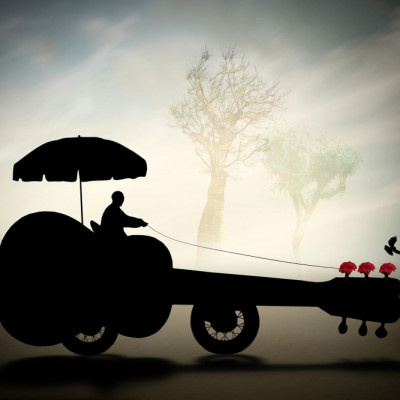SEARCH






|
|
|
|


Those who know John Flury's work can testify that he is a most creative artist. He spoils us with storytelling photographs that have a huge impact on the viewer. He considers photography as a cornerstone driving him forward unlike anything else. Thanks to Yvette Depaepe for conducting the interview. You will find more photos in the end of the article.
Could you please introduce yourself?
My name is John Flury and I was born and raised in the Alpine region of Switzerland but now live in Zurich, Switzerland's largest city. Ever since my childhood I've been in love with creating things, writing stories, drawing comics and making music. It was pretty clear to me from early on, that I wanted to become a full-time musician and so I enrolled in a music college to become a professional Jazz pianist. However the reality of an artist's life struck me pretty soon and pretty hard - having to take every gig, playing for almost nothing and fierce competition. I dropped out after two years and decided I did need art in my life but not in the form of a full-time profession. So after studying computer science I now work as a part-time IT administrator and I couldn't be happier with my current work/life balance. I still have enough time to work on photo assignments and my personal work but I can do so without the financial pressure many photographers are facing.
Can you describe your overall photographic vision?
The perceptive process an image provokes in me works like a motor. The presence of beauty and aesthetics in an image helps to jump-start that motor. The presence of a deeper meaning however will be the fuel that keeps the engine running and makes me want to come back and immerse myself again in the narrative of the image. So if the image is meaningless but beautiful, the motor will quickly run of of gas and the image is forgotten again. The perfect image is the marriage between beauty and meaning - a marriage to the point where both become inseparable.
One of the strongest carriers of meaning in art are stories - written ones, movies, comics, even music. I've made it my mission in photography to find techniques that help to create a bridge from the instant (that is photography) to the sequence of events (the story). This seems impossible at first, like trying to condense a piece of music down to a single note. But the longer I occupy myself with it, the more I discover new ways of creating that bridge.
Can you give some examples of how to condense a story into an image?
One technique I see a lot is "seeding". The image is only the seed of the story, and this seed will then grow and expand into a story in the viewer's mind. You need a special kind of audience for this, willing to be active viewers with open minds.
Another approach involves the understanding of how an image is "read". Our eyes don't take in all of the image at once, but rather jump through it - “reading” it. This creates the possibility of establishing a timeline, where early events grab the viewer's attention by being brighter, contrasty and sharp, while later events recede in the background and are discovered later by the viewer’s eyes. This falls in the category of juxtaposition, where different points in time are folded into a single image. In western cultures it makes sense to create the timeline from left to right, because we are also used to read from left to right.
A third tool I use all the time is the "outer world vs. inner world" where reality mixes with a dream-world using surreal elements. Not only does this create an interesting tension and drama, but also it shows the viewers the intentions of the subject, his self-perception, etc. Surreal elements not only are great tools for storytelling, but they also they create visual interest and can be crafted in a way that they lift up the images aesthetic quality as well - meaning and beauty again.
What is it that attracts you so much to conceptual photography?
Everything that excites me culminates in conceptual photography: stories of course, but also philosophy, psychology, sociology, interesting locations, symbolism, surrealism, dreams and fairy tales, as well as the nitty-gritty technical challenges of photo compositing. But most of all, I simply love to do creative collaborations.
Do you have a special relationship to your subject other than being an observer?
I found it most rewarding to create story concepts about people and their life's stories and themes - dreams, passions, but also struggles and fears. But it’s not just a form of portraiture. Together we carefully develop a visual, symbolic language to represent that story. This process often takes months, not just to hone in on the concept, but also to get to know each other and build trust.
Approaching difficult subjects like fears and anxieties takes a lot of patience and understanding. But the process does have an almost therapeutic effect sometimes. Through this transformation the struggle can become an expression of identity and unique beauty. This transformational function of art, for both the artist and the viewer, is what makes conceptual art so important.
I've had the tremendous luck of becoming close friends with three other massively talented visual storytellers living near me, John Wilhelm, Jurek Gralak and Christian Gerth. We call ourselves the Bunos and we are in a constant state of creative exchange, ideas, sketches, technical questions, feedbacks, etc. Through them, I've come to really appreciate humour as a means to tell a story. Serious image themes can become very accessible with the help of humour, as counter-intuitive as it sounds. A well developed concept evokes a similar reaction in the viewer to “getting a joke”. Laughing is therefore not simply a involuntary expression of amusement, but also a sign of recognition and appreciation.
What is essential to you, the story an image conveys or technical perfection?
The story behind the image defines my mission for a photo project. Once the concept is defined however, the technical challenges are something I enjoy almost just as much. Tinkering, experimenting and finding ways to make the impossible possible is something that gives me tremendous pleasure. Each project is very different and I don’t have a “one-size-fits-all” workflow. That’s because the conceptual process and the technical problem solving stages are intertwined. Sometimes it’s a back and forth until each puzzle piece clicks into place.
Do you have any advice for a beginner in conceptual photography?
Come to terms with what makes you tick as a human being. What’s the sort of stories you find yourself gravitating towards? We all do best, what we love.
Don’t limit yourself to studying the work of other concept photographers, trying to imitate what they do. You can learn from every kind of artist! Study the workflow of comic artists (e.g. how he sets up a double page, aesthetically and logically), classical painters (composition, lighting, etc.), film-makers, authors, movie script writers, etc.
Try to be original. I know it’s hard! If you are suffering a creative block, don't drown yourself in other people's work trying to get inspired again, but try to find a peaceful place and let your inner untold stories float to the surface. The universe is full of these untold stories.
What does the future hold for John? Is there anything specific you wish to achieve?
I’d love to publish a book in the next couple of years about the fundamental techniques behind story-driven conceptual photography. There are different paths this book could follow and I’m still looking for potential partners, publishers, but also other visual artists interested in collaborating on this subject.
My second goal on which I’m working on right now is getting into 3D software. I’m not tied to the idea that every pixel of my images has to originate on a camera sensor. It’s much more important to find solutions that work visually and carries my signature. So, as a matter of principle, I don’t use any stock photos.
Tell us about your all time favourite photograph taken and why is it so special to you?
My favourite photo is “Seamstress of Her Own Destiny” that was awarded with the Curator’s Choice here on 1X. Every puzzle piece just clicked perfectly into place, some of it by hard work and some simply by pure luck! I’ve had such tremendous luck with the location, a museum for sewing machines near Zurich and have become close friends with its curators as well as the model and “source of the story concept” for this photo, an amazingly talented flamenco dancer and artist herself. I feel so grateful for their support, enthusiasm and trust.
There is also a tutorial for this photo. You can find the tutorial here.
What do you think about 1X as a home base for your work?
1X has been along with me since the beginning of my photographic journey and I’ve spent so many hours in awe at the superb work of its many talented artists. I believe of all the photo platforms out there, 1X by far has the best curation process and therefore the best quality of work.
Thank you for taking the time for this interview, John. It was a real pleasure to know more about you and your work.
 | Write |
 | Ben Goossens ✝ PRO Nice to read more about you John... like your creativity:-)
Best, Ben |
 | Tib Nin <a href="https://www.rebelmouse.com/golden_pearls/essential-tips-when-buying-pearl-necklace-1051395951.html">pearl pendant</a> |
 | Tib Nin [url=https://www.rebelmouse.com/golden_pearls/essential-tips-when-buying-pearl-necklace-1051395951.html]pearl pendant[/url] |
 | Yvette Depaepe CREW Thank you so much for your fine collaboration to this great interview, John ;-) Cheers, Yvette ! |